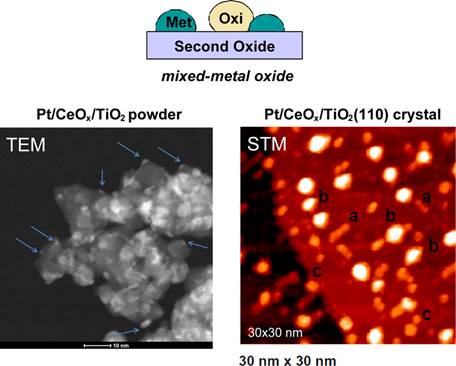- Home
-
Research Groups
Division Groups
- Artificial Photosynthesis
- Catalysis: Reactivity & Structure
- Electrochemical Energy Storage
- Electron- and Photo-Induced Processes for Molecular Energy Conversion
- Neutrino and Nuclear Chemistry
- Surface Electrochemistry and Electrocatalysis
Associated Groups
- Catalysis for Alternative Fuels Production
- Nanostructured Interfaces for Catalysis
- Structure and Dynamics of Applied Nanomaterials
- People
- Operations
- News
- Events

Catalysis: Reactivity and Structure
Fundamental Studies of Well-Defined Surfaces of Mixed-Metal Oxides: Special Properties of MOx/TiO2(110) {M = V, Ru, Ce, or W}
 In
this article, we give an overview of recent work
focused on investigating the properties of clusters or nanoparticles of VOx,
RuOx, CeOx, and WOx on
TiO2(110). Mixed-metal oxide catalysts which contain submonolayer
amounts of VOx, RuOx, CeOx,
or WOx dispersed on titania are quite important in
industrial applications and the TiO2(110) substrate is one of the
most studied oxide surfaces. As we will show, experiments with a
well-defined substrate allow better control of the structural or
morphological properties of the mixed-metal oxides, making feasible a
systematic study of these systems. Thus, one can explore relationships
between their structural, electronic, and chemical properties and improve
the understanding of the more complex powder catalysts. Experiments using
the modern techniques of surface science are giving exciting insights into
phenomena responsible for the behavior of mixed-metal oxides at the
nanometer range. The ability to control the structure of a mixed-metal oxide
at the nanometer level opens new approaches for the design of novel
catalysts.
In
this article, we give an overview of recent work
focused on investigating the properties of clusters or nanoparticles of VOx,
RuOx, CeOx, and WOx on
TiO2(110). Mixed-metal oxide catalysts which contain submonolayer
amounts of VOx, RuOx, CeOx,
or WOx dispersed on titania are quite important in
industrial applications and the TiO2(110) substrate is one of the
most studied oxide surfaces. As we will show, experiments with a
well-defined substrate allow better control of the structural or
morphological properties of the mixed-metal oxides, making feasible a
systematic study of these systems. Thus, one can explore relationships
between their structural, electronic, and chemical properties and improve
the understanding of the more complex powder catalysts. Experiments using
the modern techniques of surface science are giving exciting insights into
phenomena responsible for the behavior of mixed-metal oxides at the
nanometer range. The ability to control the structure of a mixed-metal oxide
at the nanometer level opens new approaches for the design of novel
catalysts.
Ref: Stacchiola, D.J., Senanayake, S.D., Liu, P., and Rodriguez, J.A. Chemical Reviews, 2013. 113(6): p. 4373-4390. DOI: 10.1021/cr300316v




